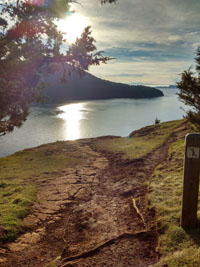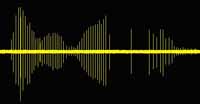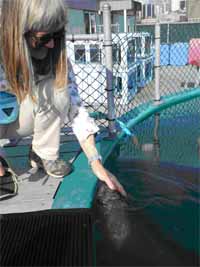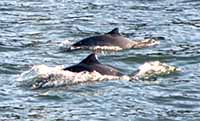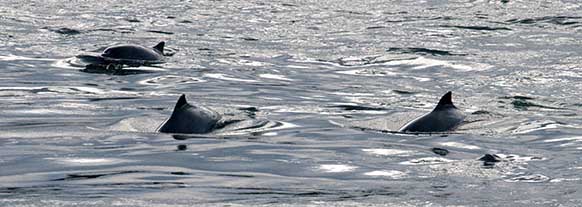Harbor Porpoise Project History
Many marine mammals have experienced substantial population declines over the last several hundred years. Large cetacean populations were decimated to the point of near extinction from whaling. Smaller marine mammals like seals, sea otter were heavily hunted for pelts. Others were killed because they were thought to be competing with human fishing harvests. From 1947 to 1960 in Washington a bounty was placed on seals because it was believed they ate significant amounts of commercially valuable fish. During that time it is estimated 17,000 seals were killed. (WDFW 2016). The Federal Marine Mammal Protection Act of 1972 now prohibits hunting, killing harassing or disturbing marine mammals. As a result, many of the marine species that have been listed as endangered, threatened or of-concern are recovering.
In addition to direct hunting, pollution, loss of habitat, bycatch, noise and human disturbance substantially reduced many marine mammal populations. The harbor porpoise has been affected by all of these factors.
The harbor porpoise population had experienced a significant decline in range and population from historic levels over the time interval 1940 to 1990. In the 1940s and 50s, it was abundant in south Puget Sound (Scheffer et. al. 1948). By the 1990s, its numbers and range had been reduced to the point that it was extirpated from south Puget Sound and rarely seen south of Admiralty Inlet (Carretta et. al. 2011, Chandler et. al., 2003). Beginning in 2007, there were anecdotal indications that the population was starting to recover. In 2015, Evenson (Evenson 2016), summarized and reported on the Audubon data from waterfowl surveys, which incidentally included data for harbor porpoise and Dall’s porpoise sightings. This single flyover, aerial survey was conducted in the seasonal interval from December through February from 1995 to 2014 and shows that the presence of the harbor porpoise in the Puget Sound had increased from 1995 to 2014. The porpoise’s distribution has changed from a concentration of animals in the Strait of Juan de Fuca and San Juan Islands, and spread into the south Puget Sound area. Surveys have recently been done by the Navy beginning in August 2013 and ending in March 2015, but the information has not been publically available, and it is not in a form that abundance can be compared to earlier work.
A significant reason for harbor porpoise decline into the 1980s is reported to have been entrapment in gill nets (Gearin 1998, Jefferson 1994, Flaherty 1982, Baird 1994a). Currently, habitat loss, decline of prey fish species, pollution and boat noise are thought to be the major contributing factors that keep the population low (Bossart 2011, Evenson 2016, Osmek 1996, NOAA 2011, NOAA 2003). In Canada, the harbor porpoise has been found to be sensitive to loss of forage fish, bycatch from gill netting, noise, human disturbance, pollution, human infectious disease and habitat loss (Baird 2003a, b). Its population trend is an indication of the health of the marine ecosystem because its population is affected by all of these environmental factors.
At present, the harbor porpoise is listed as a Candidate Species of Concern in Washington (WDFW, 2013) and a Species of Special Concern in British Columbia (Baird, 2003a). Questions have been raised as to whether gill net fishing is becoming a problem again (PBI workshop 2013). Scientists have reported a dramatically higher number of harbor porpoise strandings in recent years (Huggins 2015). Increased vessel noise from shipping (Viers 2015) and anecdotal reports of increased presence of transient orca by Orca Network (Orca Network 2016) could indicate factors that impact the harbor porpoise negatively.
NOAA has a mandate to conduct harbor porpoise stock assessments every 3 to 5 years under the Marine Mammal Protection Act, 1972, but the most recent aerial surveys are over 10 years old. WDFW has identified the harbor porpoise as a Candidate Species of Concern, but has not had the funding or information to complete the listing with a status review. The Navy initiated a set of aerial surveys beginning in August, 2013, but this information is not yet publically available. Smultea Sciences (Smultea, private communication 2015) reported on densities in 8 regions of the Puget Sound, found from her aerial surveys for the Navy, but the earlier NOAA surveys did not give densities and cannot be compared to investigate population trends. The surveys described above by Evenson are the best indication of population trends. While the harbor porpoise population has increased in the south Puget Sound, it is level to declining in the San Juan Islands and Rosario Strait. PBI’s Harbor Porpoise Project is using acoustic monitors to assess the trend of the harbor porpoise population in the northern portion of the Puget Sound.
Acoustic instruments are being used globally to monitor populations of harbor porpoises and other cetaceans. T-PODs and C-PODs have been used to estimate density of harbor porpoises in the Baltic and North Sea (Kyhn 2012, Tougaard 2009, 2014, Bailey 2010, 2014) and they have been used to estimate densities of other cetacean species (Marques et al, 2009). Behavior modification and displacement due to construction noise have been recorded by groups using acoustic instruments in the North Sea (Tougaard 2009, 2014) and Canada (Culik 2001). C-PODs have been used to study the dramatic decline in harbor porpoise in the Baltic Sea in recent decades, where the population is considered critically endangered (Benke 2014). The vaquita is also critically endangered and acoustic instruments are being used to assess the population decline which is attributed to gill net fishing (Gerrodette 2011).
One of PBI’s missions is to identify scientific tools and to develop information to aid in the protection of rare and imperiled species. A key to recovery of these species is the understanding of threats and limiting factors while these factors still can be overcome. To do this, we have been learning more about harbor porpoise habitat needs and other factors that limit the current population. As a result of our studies, we think the harbor porpoise may actually fill the role of a Sentinel Species for the Puget Sound.
Read PBI's publications related to the Harbor Porpoise Project.
 Learn more about citizen science volunteer work on this project.
Learn more about citizen science volunteer work on this project.
 Visit the volunteer resource page.
Visit the volunteer resource page.
The long term research needs for harbor porpoise conservation were documented during the Salish Sea Harbor Porpoise Workshop initiated by Pacific Biodiversity Institute, co-sponsored by Cascadia Research Collective and the Sea Doc Society, held on February 7, 2013, in Anacortes, Washington. This workshop created a Statement on Salish Sea Harbor Porpoise Research and Management Needs that is regularly referenced by Washington resource managers.
In 2009, Aileen Jeffries, a Pacific Biodiversity Institute (PBI) board member, initiated a project to monitor harbor porpoise population and trends in the Puget Sound. The long-term goal of this project is to set a baseline for the population that can be used to realistically assess the stability of the species in the Puget Sound and to consider the need for marine reserves. Another goal of the project is to determine if the harbor porpoise is, in fact, an appropriate Sentinel Species for the Puget Sound. Aileen's research results from December 2010 to the present are summarized with the PBI publications.
Historically, the population has been assessed through aerial surveys. They provide a snapshot of what is visible from the air at intervals that have been one to eight years apart. In order to collect more detailed information, PBI’s project is designed to collect porpoise occurrence and distribution data with use of passive acoustic monitors (PAMs). The current PAM being tested is the C-POD, which is deployed in several places in Western Europe and North America to monitor cetaceans. We are deploying C-PODs at selected locations to measure harbor porpoise presence/absence continuously. PBI data over successive years from the C-PODs is indicating trends in their current distribution in the northern Puget Sound. This will add to the scant body of knowledge of the harbor porpoise’s habitat use, its current range and population trends.
The presence of two porpoise species in the Puget Sound, harbor and Dall's porpoise (Phocoenoides dalli), is a complicating factor for acoustic monitoring of the harbor porpoise. Since we have visual observers at Burrows Pass and Admiralty Inlet, we can demonstrate that Dall's porpoise have not been seen in the Burrows Pass area and are rarely seen at the Admiralty site.
In 2009, we were granted access to acoustically record an orphan harbor porpoise which was being cared for by the Marine Mammal Rescue Center, Vancouver, British Columbia. Aileen Jeffries recorded high-frequency acoustic signals (clicks) from the porpoise to test the use of passive acoustic monitors. Read about Aileen’s work with Daisy, the rescued harbor porpoise.
At present we have six C-PODs that are being deployed. Our long-term goal for this initiative is to develop a geo-spatial model that can help predict the optimal habitat for the harbor porpoise based on biophysical data and knowledge of the behavioral ecology of the animal.
References
Bailey, H., G. Clay, E.A. Coates, D. Lisseay, B. Senior, P. M. Thompson. 2010. Using T-PODs to assess variations in the occurrence of coastal bottlenose dolphins and harbour porpoises. Aquatic Conservation: Marine and Freshwater Ecosystems, @): 150-158
Bailey et al. 2014. Assessing environmental impacts of offshore wind farms: lessons learned and recommendations for the future. Aquatic Biosystems 10:8.
Baird, R. 2003a. COSEWIC Assessment and Update Status Report on the Harbour Porpoise Phocoena phocoena (Pacific Ocean Population) in Canada. COSEWIC Committee on the Status of Endangered Wildlife in Canada. 22 p.
Baird, R.W., M. B. Hanson, E.E. Ashe, M. R. Heithaus, G. J. Marshall. 2003. Studies of Foraging in "Southern resident" Killer Whales during July 2002: Dive depths, bursts in speed, and the use of a "Crittercam" system for examining sub-surface behavior. Biology Dept., Dalhouse University, Halifax, Nova Scotia, Canada.
Baird, R. W. 1994a. A program to monitor the status of small cetaceans in British Columbia. First Annual Pacific Ecozone Workshop, Sidney, B. C., Feb 1–3, 1994, 122–131.
Baird, R. 1994b. BC Sightings Program Technical Report Series No. 222, Pacific and Yukon Region, Canadian Wildlife Service. 130
Benke, H., S. Brager et al. 2014. Baltic Sea harbour porpoise populations: status and conservation needs derived from recent survey results. Marine Ecology Progress Series. Vol. 495: 275–290, 2014 doi: 10.3354/meps10538
Bossart, G. D. 2011. Marine Mammals as Sentinel Species for Oceans and Human Health. Vetenary Pathology 48(3) 676-690
Bossart, G. D. 2006. Marine Mammals as Sentinel Species for Oceans and Human Health Oceanography. Vol 19 No 2 134-138 p.
Carretta, J. V., K. A. Forney, E. Oleson, K. Martien, J. Barlow, B. Hanson. 2011. U.S. Pacific Marine Mammal Stock Assessments: 2011NOAA-TM-NMFS-SWFSC-488 U. S. Department of Commerce. National Oceanic and Atmospheric Administration, National Marine Fisheries Service, Southwest Fisheries Science Center
Chandler, T., J. Calambokidis. 2003. Aerial surveys for harbor porpoise and other marine mammals off Oregon, Washington and British Columbia. Contract Report for National Marine Mammal Laboratory. 282 p.
Chelonia. 2012. (http://www.chelonia.co.uk/ last accessed 2016)
Culik, B. M., S. Koschinski, N. Tregenza, G. M. Ellis. 2001. Reactions of harbor porpoises Phocoena phocoena and herring Clupea harengus to acoustic alarms. Marine Ecology Progress Series 211:255–260.
Evenson, J.R., D. Anderson, B.L. Murphie, T.A. Cyra, and J. Calambokidis. 2016. Disappearance and return of harbor porpoise to Puget Sound: 20 year pattern revealed from winter aerial surveys. Technical Report.
Washington Department of Fish and Wildlife, Wildlife Program and Cascadia Research Collective, Olympia, WA.
Flaherty, C., S. Stark. 1982. Harbor porpoise (Phocoena phocoena) assessment in Washington Sound. Final Report for Subcontract 80-ABA-3584, NOAA, NMFS, National Marine Mammal Laboratory, Seattle, WA. 84 p.
Gearin, P. J., M. E. Gosho, J. L. Laake, L. Cooke, R. L. DeLong, K. M. Hughes. 1998. Experimental testing of acoustic alarms (pingers) to reduce bycatch of harbour propoise, Phocoena phocoena, in the state of Washington.J. Cetacean Res. 2(1)1-9.
Gerrodette, T., L. Rojas-Bracho. 2011. Estimating the success of protected areas for the vaquita, Phocoena sinus. MARINE MAMMAL SCIENCE, 27E101–E125
Hall, A. 2011. Foraging behaviour and reproductive season habitat: Selection of northeast pacific porpoises. PhD thesis, University of British Columbia, Vancouver, BC. 197 p.
Hall, A. M. 2004. Seasonal abundance, distribution and prey species of harbour porpoise (Phocoena phocoena) in Southern Vancouver Island Waters. University of British Columbia, Department of Zoology, Vancouver. 109 p.
Hanson, M.B., R.W. Baird and R.L. DeLong. 1999. Movements of a tagged harbor porpoise in inland Washington waters from June 1998 to January 1999.AFSC Processed Report. 99.08. pp. 85-86
Hanson, M.B. 2007a. Using Location Data from Telemetry Tagged Marine Mammals to Improve Stock Assessments. Pp 62-63, In Sheridan, P., J. W. Ferguson, and S. L. Downing
Huggins, J. L., S. A. Raverty, J. Calambokidis et al. 2015. Increased harbor porpoise mortality in the Pacific Northwest, USA: understanding when higher levels may be normal DISEASES OF AQUATIC ORGANISMS Vol. 115: 93–102, 2015 doi: 10.3354/dao02887Inter-Research 2015 · www.int-res.com
Jefferson, T. A., B. E. Curry. 1994. Global review of porpoise (Cetacea: Phocoenidae) mortality in gillnets. Biological Conservation 67:167-183
Jeffries, A. 2011. Harbor Porpoise Observations in Burrows Pass December 2009 through December 2010. Pacific Biodiversity Institute. Winthrop, Washington. 27 p.
Jeffries, A. 2012. Passive Acoustics: An effective monitoring technique for the harbor porpoise - 2011 to 2012, Pacific Biodiversity Institute, Winthrop, Washington. 15 p.
Jeffries, A. 2014. Land-Based Observations of Harbor Porpoise in Burrows Pass, 2011 to 2013. Pacific Biodiversity Institute, Winthrop, Washington. 23 P.
Kyhn, L. A., J. Tougaard, L. Thomas, L. R. Duve, J. Stenback, M. Amundin, G. Desportes, J. Teilmann. 2012. From echolocation clicks to animal density—Acoustic sampling of harbor porpoises with static data loggers. JASA 131:550-560.550-560.
Marques, T. A., L. Thomas, J. Ward, N. DiMarzio, P. L. Tyack. 2009. Estimating cetacean population density using fixed passive acoustic sensors: An example with Blainville’s beaked whales. JASA 125(4) 1982-1994.
NOAA. 2003. Marine Mammal Stock Assessment Reports (SARs) http://www.nmfs.noaa.gov/pr/pdfs/sars/po2003poha-wain.pdf. (Last referenced 23 October 2013).
NOAA. 2011. National Oceanic and Atmospheric Administration. Revised 12/15/2011. Harbor Porpoise (Phocoena phocoena vomerina): Washington Inland Waters Stock Available online at http://www.nmfs.noaa.gov/pr/pdfs/sars/po2011poha-wain.pdf. (Last referenced 23 October 2013).
Orca Network (http://www.orcanetwork.org/Main/ referenced June 26, 2016)
Osmek, S., J. Calambokidis, J. Laake, P. Gearin, R. DeLong, J. Scordino, S. Jeffries, and R. Brown. 1996. Assessment of the status of harbor porpoise, Phocoena phocoena, in Oregon and Washington waters. U.S. Dep. Commer., NOAA Tech. Memo. NMFS-AFSC-76. 46.
Read, A. J., W. A. Watkins, A. J. Westgate. 1996. Development and Testing of Tagging and Attachment Equipment for Harbor Porpoises in the SW Bay of Fundy. Final Report to Office of Naval Research, October 31, 1996Final Report N00014-94-1-1189 ONR
Read, A. J., A. J. Westgate. 1997. Monitoring the movements of harbour porpoises (Phocoena phocoena) with satellite telemetry. Marine Biology (130) 315-322.
Scheffer, V. B., J. W. Slipp. 1948. The whales and dolphins of Washington State with a key to the cetaceans of the west coast of North America. American Midland Naturalist 39:257–337
Smultea, M., T. Jefferson. 2015. Regional and Seasonal Density and Abundance of Harbor Porpoises
Starkhammar, J., J. Nilsson, M. Amundin, S. A. Kuczaj II, M. Almqvist and H. W, Persson. 2011. Separating overlapping click trains originating from multiple individuals in echolocation recordings. JASA, 129(1) 458-466
Tougaard, J., J. Carstensen, J. Teilmann, H. Slov, P. Rasmussen. 2009. Pile driving zone of responsiveness extends beyond 20 km for harbor porpoises (Phocoena phocoena (L.)) (L) J. Acoust. Soc. Am. 126 1,11-14
Tougaard, J., A. J. Wright, P. T. Madsen. 2014. Cetacean noise criteria revisited in the light of proposed exposure limits for harbour porpoises. Marine Pollution Bulletin 90 (2015) 196–208
Vancouver Aquarium. https://www.vanaqua.org/act/direct-action/marine-mammal-rescue/tracking (Last referenced March 20, 2016).
WDFW. 2013. WDFW Species of Concern Web Page. http://wdfw.wa.gov/conservation/endangered/. (Last referenced August 2013).
WDFW. 2016. http://www.ecy.wa.gov/programs/sea/pugetsound/species/seal.html . (Referenced June 26, 2016).
Copyright © Pacific Biodiversity Institute
PO Box 298, 517 Lufkin Lane
Winthrop, WA 98862 509-996-2490
